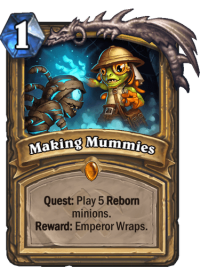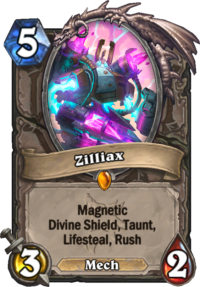Our Quest Paladin deck list guide for the Saviors of Uldum expansion features one of the top lists for this archetype. This Paladin guide includes Mulligan Strategy, Gameplay Tips, Card Substitutions, and Combos/Synergies!
Introduction

Quest Paladin is a brand new archetype spawned by Saviors of Uldum, one which revolves around Reborn minions and the payoff of a value-generating hero power that’s strong enough to flood even a Control Warrior’s board over time. In fact, the deck’s remarkably sturdy results against said archetype is the main reason why it’s worth exploring right now, as it’s one of the very few reliable counters to Warrior at the time of writing, though its anti-aggro capabilities leave a lot to be desired. This is why the featured build opts to include many of the cards that are meant to help against aggression instead of the greedier options – for those, refer to the “Card Replacements” section at the bottom of the guide!
To be honest, viability of this deck was surprising for many players. It was rated as one of the worst Quests before expansion’s launch. As it turned out, however, it’s quite easy to finish reliably around Turn 5-6, and then it can produce a constant flow of Mechnical Whelps or Mechano-Eggs just for 2 mana, making it really scary (especially you throw in a Zilliax or at least Annoy-o-Module for Taunt + Divine Shield on those). Once you get to that point, the deck becomes very difficult to beat.
- 0Reborn (Quest) Paladin Deck List Guide – Saviors of Uldum – August 20191
- 0Reborn (Quest) Paladin Deck List Guide – Saviors of Uldum – August 20192
- 0Reborn (Quest) Paladin Deck List Guide – Saviors of Uldum – August 20192
- 1Crystology2

- 1Making Mummies1

- 2Micro Mummy2

- 4Ancestral Guardian2

- 4Annoy-o-Module2

- 5Mechano-Egg2

- 7Kangor’s Endless Army1

Mulligan Guide and Strategy

Higher Priority (Keep every time)
- Making Mummies – Unlike with some other Quests in the past, there’s no scenario under which you’d like to have a different card, even when you’re playing against an aggressive opponent. Your whole gameplan revolves around completing this as soon as possible.
- Crystology – A no-brainer of a tutor tool, especially since its surprise buff in Rise of the Mechs. It will draw you many of your cheap Reborn minions as follow-ups.
- Questing Explorer – Similarly, a great re-draw tool, and one that you want to get your hands on as early as possible to make sure you can play it before its ability expires.
- Murmy, Temple Berserker and Candletaker – These are the cheap Reborn minions required to quickly advance your quest, and the cards to construct your early gameplan around.
Lower Priority (Keep only if certain conditions are met)
- Bone Wraith – A great stall option that progresses your quest, but it’s too slow if you don’t have any other playable cards. Keep with any other previous play and/or the Coin.
- Ancestral Guardian – Only keep this against aggressive opposition and if you have playable cards for the previous turns.
General Playstyle and Strategy
Vs Aggro

While Quest Paladin does struggle against aggressive opposition, there are a few tricks you can pull off to at least marginally improve your winrate. Perhaps most importantly, remember that your anti-aggro gameplan doesn’t revolve around the immediate completion of the quest. This is not Quest Druid: since you only have limited board and health recovery tools (more on the reasons behind that in the Card Replacements section), it’s often more beneficial to taunt up or to remove a threat than to mechanically place down the next Reborn minion that’s available to you.
Always clear your opponent’s board as efficiently as possible, and when it isn’t, try to protect your face. You won’t need to squeeze out every bit of value from your cards and hero power to win these matchups. Your only goal is to set up an impenetrable wall late into the game. Since your shut-out gameplan will inevitably take time to execute, you might want to consider holding back Ancestral Guardian on curve: in certain cases, you won’t yet get any healing from it, and you also deny yourself the opportunity to eventually double-dip on its Lifesteal ability with your post-quest reward hero power.
Vs Control

These are the matchups where Quest Paladin truly shines. As long as you don’t lose the board in such devastating fashion that your opponent can directly threaten lethal, you’ll have basically infinite resources to work with as you establish sticky board after sticky board with ease. In fact, it’s specifically the great Control Warrior matchup which makes this deck viable in the current metagame: since it struggles to apply pressure, instead opting for a slow and steady stream of consistent value generated by the quest reward, it can be remarkably difficult to push damage on your opponent even if you get to create extra Mechano-Eggs every turn.
This is very important to keep in mind: even against another slow deck, expect to play a control strategy and your opponent to assume the role of the beatdown. Conjurer Mages will try to flip the game by pushing damage with a board of Mountain Giants, and even Warriors’ best shot against you will be to try to ignore your minions for a crucial turn or two and hit you directly. As such, don’t undervalue your healing tools in these matchups and only consider face damage over trading if you can generate multiple big minions off of the deathrattles of Mechano-Egg or Mechanical Whelp on the same turn to actually threaten lethal on the follow-up. Of course, proactively trading in these minions runs the risk of losing out on value from your hero power if your opponent does manage to clear: this is why you should be very selective with your damage pushes.
Card Replacements
The real difference between the popular Quest Paladin builds revolves around the kind of cards to use as part of the anti-aggro gameplan. Whether it’s a better idea to add more Magnetic Taunts or to utilize removal options like Truesilver Champion or Consecration depends at least in part on the kind of opposition you’re facing. Paradoxically enough, the latter removal tools are quite ineffective against the minion-based aggro decks you’d expect them to shine against, simply because there aren’t enough such tools in Quest Paladin. Even if you clear two waves of minions, inevitably a third will follow, and if you can’t block that damage, you’re likely going to lose the game. This is why the currently popularized Quest Paladin builds tend to rely on Bronze Gatekeeper and Annoy-o-Module instead: not only do they mean that a well-timed Kangor's Endless Army immediately ends the game against aggressive opponents, they also mean that you’ll have an easier time to generate damage blockers with your hero power once the quest is completed. Since there are only three direct healers in the normal deck (the two copies of Ancestral Guardian and Zilliax), you will need to be able to negate the opponent’s minion pressure throughout the entire game, not just once or twice in crucial situations.
Since the whole reason behind playing this deck is to counter Warriors, there’s only so much potential that’s worth giving up against it to shore up your anti-aggro matchups. However, this is exactly why we’ve decided to feature a build with two copies of Khartut Defender and double Questing Explorer instead of cards like Wargear or Truesilver Champion: that said, they are definitely viable options to consider as well.







